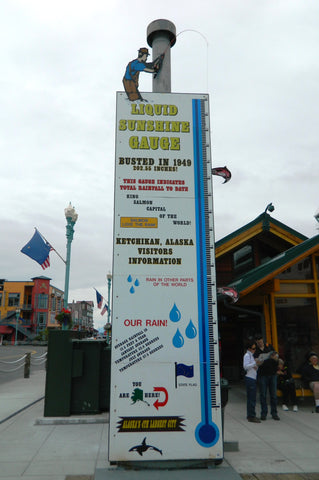For those of us who live in Ketchikan, we know that the topic of UV rays isn’t something we necessarily have to talk about often. If you’ve ever visited Ketchikan by cruise ship, you might remember our "Liquid Sunshine Gauge" by the Visitor’s Center. A popular spot for tour groups to meet and depart from, it shows our year to date rainfall. Ketchikan famously receives about 13 feet of rain a year and boasts lush, green rainforest and gushing salmon streams because of our abundance of this so called liquid sunshine.

However with the recent and unseasonable influx of sunlight in our little Alaskan rainforest town, we were inspired to address public enemy number 1 to your artwork: damaging UV rays.

When it comes to artwork, unfortunately we tend not to give light much thought until the damage is done. It’s important to be aware that light can cause permanent damage to prints, drawings, textiles and even paintings.
Now before you go slapping sunscreen on your pieces (which we wholeheartedly DO NOT recommend), let’s take a step back and consider the facts and the options.
While the absolute best way to preserve art is to keep it in a cool, dark place for eternity, that’s generally not the best way to enjoy it. Instead of leaving the walls of bright rooms bare, we advise to simply choose wisely when considering the placement of your artwork and to have pieces framed with UV protecting materials.

Know the enemy:
Ultraviolet Light –Sunlight is a common source of ultraviolet light. Ultraviolet radiation is potentially damaging to all works on paper, photographs, library and archive collections, leather, household fabrics, and collectibles (and of course, skin without sunscreen). It is more pronounced in sunlight and fluorescent light than in incandescent light.

Know how to fight back:
UV Filtering Materials – in order to protect your artwork from damaging UV rays, we use Conservation Clear® glass from TruVue that protects from 99% of UV rays. Conservation Clear® picture framing glass offers the highest level of UV protection available in the industry.
When To Use:
- For protecting art, photographs and other important personal keepsakes against damage and fading caused by UV light
- To provide fade protection for posters. The inks, papers and other materials used to create these prints are more likely to deteriorate at a faster pace than higher quality reproductions

If you purchase a ready made frame from a retail store or online, chances are that the frame uses basic glass. Basic glass protects your art from dust and scratches only. It does not protect your artwork from harmful UV rays or contain any anti-reflective properties. Another common material used in store bought frames is styrene. This is a non-glass option that is generally used because it's cheap and lightweight. Styrene, much like basic glass, only provides physical protection from dust and scratches.
Simple Placement – Exposure to intense sunlight can drain the color not just from artwork, but from almost anything. Avoid hanging your artwork anywhere where it will receive regular doses of direct sunlight. If you're living space gets tons of natural light, draw blinds or shades during the brightest part of the day. Also consider rotating works of art periodically.
Knowing How Different Pieces May React – Some works can withstand sunlight better than others. For example, an original oil painting will fade very little in indirect sunlight as long as there is no canvas exposed (sunlight will damage the raw canvas.) If you're ever been to any art museum, you may have noticed that many of the historical paintings on display are oil paintings. Oil paintings are known for standing the test of time more so than other art media.

On the other hand, you should never hang a watercolor or original drawing in sunlight. Watercolors are especially vulnerable to fast fading. And unfortunately for sensitive mediums like watercolors or textiles, UV protection on the glass isn't enough. These pieces should pretty much stay permanently in a well-shaded spot like a hallway or a dark bedroom so that their brilliant colors won’t get washed out. The same goes for works on paper and photography, as even most indirect light can cause fading.
Summing It Up – Basically the sun will fade anything over time. And some pieces will fade faster than others. Whether your art collection consists of super pricey or super priceless pieces that can't be replaced, we recommended having things framed with UV protection and avoid hanging pieces in direct sunlight. If you have a piece already in a frame but want UV protection, we're always happy to cut UV glass to fit into the frame you already have.
As always, feel free to get in touch with us about any concerns you may have about your artwork or questions about protecting your special pieces from damage.
Artfully yours,
Maria at Scanlon's
